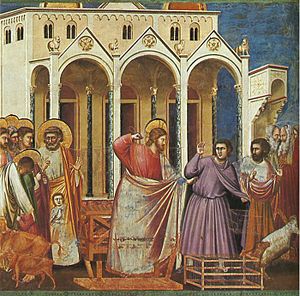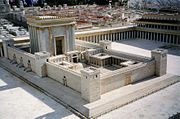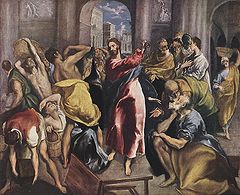- Cleansing of the Temple
-
The narrative of Jesus and the money changers, commonly referred to as the cleansing of the Temple, occurs in all four canonical gospels of the New Testament.
In this episode Jesus and his disciples travel to Jerusalem for Passover, where he expels the money changers from the Temple, accusing them of turning the Temple to a den of thieves through their commercial activities.[1][2] In the Gospel of John Jesus refers to the Temple as “my Father’s house” thus in some views making a claim to being the Son of God.[3]
This is the only account of Jesus using physical force in any of the Gospels. The narrative occurs near the end of the Synoptic Gospels (at Mark 11:15–19, 11:27–33, Matthew 21:12–17, 21:23–27 and Luke 19:45–48, 20:1–8) and near the start in the Gospel of John (at John 2:13–16). Some scholars believe that these refer to two separate incidents, given that the Gospel of John includes more than one passover.[4]
Contents
Description
In this episode, Jesus is stated to have visited the Temple in Jerusalem, Herod's Temple, at which the courtyard is described as being filled with livestock and the tables of the money changers, who changed the standard Greek and Roman money for Jewish and Tyrian money.[1] Jerusalem was packed with Jews who had come for Passover, perhaps comprising 300,000 to 400,000 pilgrims.[5][6]
Creating a whip from some cords, “he drove them all out of the temple, with the sheep and the oxen, and poured out the changers’ money and overturned the tables. But he said to those who sold doves, ‘Get these out of here! Do not make My Father’s house a house of merchandise!’[Jn 2:13-16]”
“ And Jesus went into the temple of God, and cast out all of them who sold and bought in the temple, and overthrew the tables of the moneychangers, and the seats of them that sold doves, And said unto them, It is written, My house shall be called the house of prayer; but ye have made it a den of thieves.
” In John, this is the first of the three times that Jesus goes to Jerusalem for the Passover, and John says that during the Passover Feast there were (unspecified) miraculous signs performed by Jesus, which caused people to believe in his name, but that he would not entrust himself to them, for he knew all men.[4][7]
In Mark 12:40 and Luke 20:47 Jesus again accuses the Temple authorities of thieving and this time names poor widows as their victims going on to provide evidence of this in Mark 12:42 and Luke 21:2. Dove sellers were selling doves that were sacrificed by the poor who could not afford grander sacrifices and specifically by women. According to Mark 11:16, Jesus then put an embargo on people carrying any merchandise through the temple—a sanction that would have disrupted all commerce.[4][7]
Matthew says the Temple leaders questioned Jesus if he was aware the children were shouting Hosanna to the Son of David, and Jesus responded by accepting the worship of the children as valid by quoting "from the lips of children and infants you have ordained praise" from the Book of Psalms (Psalm 8:2).[4][7]
Chronology
The Temple cleansing episode in the Gospel of John can be correlated with non-biblical historical data sources to obtain an estimate for the year to which the episde refers. John 2:13 states that Jesus went to the Temple in Jerusalem around the start of his ministry and John 2:20 states that Jesus was told:[8][9]
- "Forty and six years was this temple in building, and you want to raise it up in three days?".
In the Antiquities of the Jews, first century historian Flavius Josephus wrote that (Ant 15.380) the temple reconstruction was started by Herod the Great in the 15th-18th year of his reign at about the time that Augustus arrived in Syria (Ant 15.354).[10][9][11][12] Temple expansion and reconstruction was ongoing, and it was in constant reconstruction until it was destroyed in 70 AD/CE by the Romans.[13] Given that it took 46 years of construction, the Temple visit in the Gospel of John has been estimated at around 27-29 AD/CE.[8][9][14][15][16]
In Art
The Cleaning of the Temple is a commonly depicted event in the Life of Christ. El Greco painted numerous paintings of the event.
Old Testament comparison
An incident where provocation took place in the Temple can be found in the time of Nehemiah, when Nehemiah overturned the furniture of Tobiah the Ammonite who had, with the cooperation of Eliashib the High Priest, leased the storerooms of the temple, depriving the Levites of their rations from the offerings, and drove out Eliashib's grandson who had married the daughter of Sanballat the Horonite (Neh 13).[17][citation needed]
See also
References
- Brown, Raymond E. An Introduction to the New Testament, Doubleday (1997) ISBN 0-385-24767-2
- Brown, Raymond E. The New Jerome Biblical Commentary, Prentice Hall (1990) ISBN 0-13-614934-0
- Ched Myers, Binding the Strong Man: A political reading of Mark's story of Jesus, Orbis (1988) ISBN 0-88344-620-0
- Miller, Robert J. The Complete Gospels, Polebridge Press (1994), ISBN 0-06-065587-9
Notes
- ^ a b Sanders, E. P. The historical figure of Jesus. Penguin, 1993.
- ^ Ehrman, Bart D.. Jesus, Interrupted, HarperCollins, 2009. ISBN 0061173932
- ^ The International Standard Bible Encyclopedia by Geoffrey W. Bromiley 1988 ISBN 0802837859 page 571-572
- ^ a b c d The Bible knowledge background commentary by Craig A. Evans 2005 ISBN 0781442281 page 49
- ^ Sanders, E. P. The historical figure of Jesus. Penguin, 1993. p. 249
- ^ Funk, Robert W. and the Jesus Seminar. The acts of Jesus: the search for the authentic deeds of Jesus. HarperSanFrancisco. 1998.
- ^ a b c The Fourth Gospel And the Quest for Jesus by Paul N. Anderson 2006 ISBN 0567043940 page 158
- ^ a b Paul L. Maier "The Date of the Nativity and Chronology of Jesus" in Chronos, kairos, Christos: nativity and chronological studies by Jerry Vardaman, Edwin M. Yamauchi 1989 ISBN 0931464501 pages 113-129
- ^ a b c Eerdmans Dictionary of the Bible 2000 Amsterdam University Press ISBN 9053565035 page 249
- ^ The Cradle, the Cross, and the Crown: An Introduction to the New Testament by Andreas J. Köstenberger, L. Scott Kellum 2009 ISBN 9780805443653 pages 140-141
- ^ Encyclopedia of the historical Jesus by Craig A. Evans 2008 ISBN 0415975697 page 115
- ^ As stated by Köstenberger & Kellum (page 114) there is some uncertainty about how Josephus referred to and computed dates, hence various scholars arrive at slightly different dates for the exact date of the start of the Temple construction, varying by a few years in their final estimation of the date of the Temple visit.
- ^ Eerdmans Dictionary of the Bible, page 246 states that Temple construction never completed, and that the Temple was in constant reconstruction until it was destroyed in 70 AD/CE by the Romans, and states that the 46 years should refers to the actual number of year from the start of the construction.
- ^ The Riddles of the Fourth Gospel: An Introduction to John by Paul N. Anderson 2011 ISBN 080060427X page 200
- ^ Herod the Great by Jerry Knoblet 2005 ISBN 0761830871 page 184
- ^ Jesus in Johannine tradition by Robert Tomson Fortna, Tom Thatcher 2001 ISBN 9780664222192 page 77
- ^ The Bible Knowledge Commentary: Old Testament Walter L. Baker, Roy B. Zuck 1985 ISBN 0882078135 page... Needs page number...
Cleansing of the TemplePreceded by
Wedding in Cana in John 2or Triumphal Entry in the Synoptic Gospels
New Testament Events
Succeeded by
Jesus & Nicodemus in John 3or Fig Tree Cursed in the Synoptic Gospels
Categories:- Gospel episodes
- Perspectives on Jesus
- Christianity in Jerusalem
Wikimedia Foundation. 2010.



